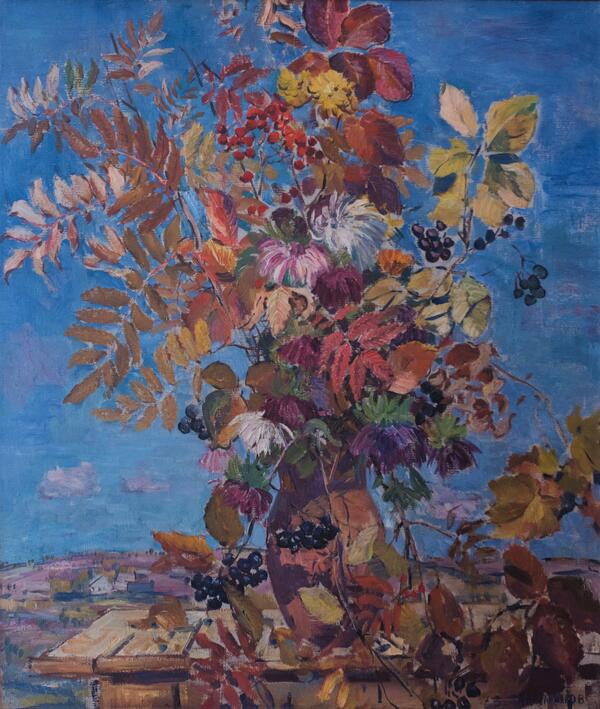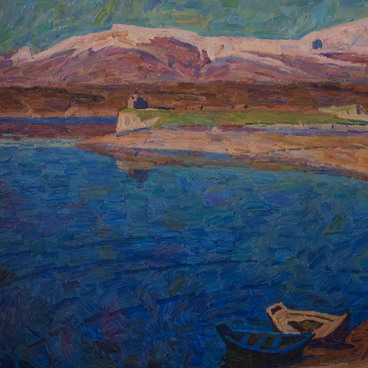In the work “Autumn Leaves” artist Boris Shamanov combined the expressive means of floral still life painting and rural landscape. This method became a distinctive feature of the artist’s style.
The artist divided space of the canvas into two planes — two sharply separated planes. He depicted a three-dimensional jug with a bouquet of autumn leaves and branches with berries in the foreground, and a barely visible rural landscape far in the background. It expands the scope of the composition and significantly adds to the depth of the image.
The chosen perspective allowed Shamanov to paint the autumn bouquet against the background of the sky, which changes: white clouds can be seen in the distance, and the sky’s color varies from light blue near the horizon to dark blue and purple at the upper edge of the painting.
Boris Shamanov was born on September 15, 1931 in Leningrad. In 1945, he tried to enter a nautical school, but he was too young and was not accepted.
From 1948 to 1956, Shamanov studied at the Leningrad Higher School of Art and Industry, first at the Department of Artistic Metalwork, then at the Department of Decorative and Monumental Painting and at the workshop of artist-monumentalist Anatoly Kazantsev.
Since 1957, Shamanov participated in collective exhibitions, exhibited his works along with other famous Leningrad masters of fine arts. He painted portraits, landscapes, genre compositions. He worked with watercolor, gouache, oil and tempera. In 1960, Shamanov was accepted into the Leningrad Union of Artists.
For nearly half a century, from 1960 to 2008, the artist taught at the Saint Petersburg Stieglitz State Academy of Art and Design (formerly — Vera Mukhina School). He was head of the Department of General Painting from 1988 to 2008. In 1984, Boris Shamanov was awarded the title of Honored Artist of the RSFSR, in 1995 — the title of People’s Artist of the Russian Federation.
Boris Shamanov died in 2008 in St. Petersburg. Today his works are housed in the Russian Museum, the Tretyakov Gallery, as well as in museums and private collections in Germany, Britain, France, USA, Italy and other countries.
The artist divided space of the canvas into two planes — two sharply separated planes. He depicted a three-dimensional jug with a bouquet of autumn leaves and branches with berries in the foreground, and a barely visible rural landscape far in the background. It expands the scope of the composition and significantly adds to the depth of the image.
The chosen perspective allowed Shamanov to paint the autumn bouquet against the background of the sky, which changes: white clouds can be seen in the distance, and the sky’s color varies from light blue near the horizon to dark blue and purple at the upper edge of the painting.
Boris Shamanov was born on September 15, 1931 in Leningrad. In 1945, he tried to enter a nautical school, but he was too young and was not accepted.
From 1948 to 1956, Shamanov studied at the Leningrad Higher School of Art and Industry, first at the Department of Artistic Metalwork, then at the Department of Decorative and Monumental Painting and at the workshop of artist-monumentalist Anatoly Kazantsev.
Since 1957, Shamanov participated in collective exhibitions, exhibited his works along with other famous Leningrad masters of fine arts. He painted portraits, landscapes, genre compositions. He worked with watercolor, gouache, oil and tempera. In 1960, Shamanov was accepted into the Leningrad Union of Artists.
For nearly half a century, from 1960 to 2008, the artist taught at the Saint Petersburg Stieglitz State Academy of Art and Design (formerly — Vera Mukhina School). He was head of the Department of General Painting from 1988 to 2008. In 1984, Boris Shamanov was awarded the title of Honored Artist of the RSFSR, in 1995 — the title of People’s Artist of the Russian Federation.
Boris Shamanov died in 2008 in St. Petersburg. Today his works are housed in the Russian Museum, the Tretyakov Gallery, as well as in museums and private collections in Germany, Britain, France, USA, Italy and other countries.



